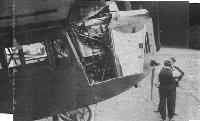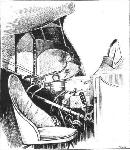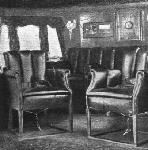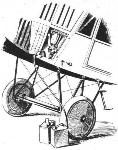
Описание
Страна : Нидерланды
Год : 1921
Транспортный самолет с экипажем из одного человека
Fokker F.III
Самолет F.III был создан на базе F.II и отличался от него укороченным фюзеляжем большей ширины, в комфортной кабине которого могли разместиться пять пассажиров. Пилот сидел перед передней кромкой высокорасположенного свободнонесущего крыла в открытой кабине, смещенной к правому борту. Крыло имело толстый профиль и типичную для "Fokker" деревянную конструкцию с фанерной обшивкой. Шасси с хвостовым костылем имели на основных опорах одиночные колеса, установленные на общей оси, и по сравнению с F.II на самолете была увеличена высота руля направления.
Прототип, оснащенный двигателем BMW IIIa мощностью 185 л.с. (138 кВт), впервые поднялся в воздух в Шверине в начале апреля 1921 года, а уже 14 апреля его передали авиакомпании KLM. Машина также экспонировалась на Парижском авиасалоне 1921 года, но собрала неоднозначные отзывы, во многом благодаря недоброй памяти о службе самолетов Фоккера Германии в годы Первой мировой войны. Тем не менее, к середине 1920-х годов F.III стал одним из самых распространенных европейских транспортных самолетов.
Из 31 машины F.III, построенной "Fokker", 12 машин, оснащенных двигателем Armstrong Siddeley Puma в 240 л. с. (179 кВт), были переданы авиакомпании KLM, начавшей их интенсивную эксплуатацию уже в 1921 году. Другими покупателями стали германская авиакомпания "Deutsche Luft-Reederei" (самолеты с двигателями BMW IIa) и венгерская "MALERT", использовавшая шесть F.III (четыре с двигателем BMW IIIa и два - с двигателем Hiero в 230 л.с./172 кВт) на линиях между Будапештом, Веной и Грацем. Один F.III совершил демонстрационный тур по Северной Америке, но там удалось продать всего два самолета. F.III позднего выпуска, оснащенные двигателями Rolls-Royce Eagle мощностью 360 л. с. (268 кВт), имели кабину пилота сдвинутую к левому борту, и на части из них устанавливалось подкосное крыло-парасоль. Советско-германская авиакомпания "Deruluft" в 1922 году приобрела 10 таких F.III, а еще две машины купила компания KLM. Последние в 1925 году переоснастили радиальными двигателями Gnome-Rhone (Bristol) Jupiter VI в 400 л. с. (298 кВт) и использовали на линии между Амстердамом и Парижем. В 1926 году пять уцелевших F.III были проданы швейцарской авиакомпании "Balair", и 28 апреля они группой перелетели к новому месту приписки в Базель.
В 1923 году выпуск F.III начался в Германии на заводе фирмы "Staaken", и авиакомпания "Deutsche Aero Lloyd" приобрела как минимум 20 самолетов, называвшихся Fokker-Grulich F.III. Некоторые из них были оснащены двигателями BMW IV мощностью 250 л. с. (186 кВт), а на остальных стояли Puma. Позднее несколько самолетов оснастили двигателями BMW Va в 320 л. с. (239 кВт), изменив обозначение на F.IIIc. Когда в 1926 году была организована авиакомпания "Deutsche Lufthansa", в ее парке насчитывалось свыше 16 F.III, работающих на линии между Гамбургом и Амстердамом. Позднее их перевели на короткие линии, связывающие города на северном побережье Германии, а затем использовали для перевозки грузов. В 1929 году два F.III были проданы авиакомпании "British Air Lines Ltd.", базировавшейся в аэропорту Кройдон.
Варианты
Grulich V1: самолет отличался измененной конструкцией фюзеляжа, оперения и шасси, первоначально оснащался двигателем Rolls-Royce Eagle VIII; после замены на двигатель воздушного охлаждения Gnome-Rhone обозначение изменили на V 1а; вариант использовался авиакомпанией "Deruluft"
Grulich V 2: аналогичен по конструкции варианту V1, за исключением шасси от F.III; вероятно оснащался двигателем BMW IV
ТАКТИКО-ТЕХНИЧЕСКИЕ ХАРАКТЕРИСТИКИ
Fokker F.III
Тип: транспортный самолет с экипажем из одного человека
Силовая установка: один рядный ПД Armstrong Siddeley Puma мощностью 240 л. с. (179 кВт)
Летные характеристики: максимальная скорость у земли 150 км/ч; крейсерская скорость на оптимальной высоте 135 км/ч; продолжительность полета 5 ч
Масса: пустого 1200 кг; максимальная взлетная 2000 кг
Размеры: размах крыла 17,62 м; длина 11,07 м; высота 3,66 м; площадь крыла 39,10 м2
Полезная нагрузка: до пяти пассажиров в закрытой кабине
Описание:
- Fokker F.III
- Flight, April 1921
THE OPENING OF THE K.L.M. LONDON-AMSTERDAM SERVICE - Flight, May 1921
THE FOKKER F III COMMERCIAL MONOPLANE
Фотографии
-
Мировая Авиация 135
Регистрационный номер: H-NABL [3] Интересно, что "Fokker" построила два F.III с регистрационным номером H-NABL. Оба самолета принадлежали авиакомпании KLM, но второй позднее использовался как источник запчастей для третьей машины. Помимо самолетов производства "Fokker", KLM сама занималась изготовлением F.III. Как минимум одна машина была собрана из запасных частей и узлов второго H-NABL, и есть информация, что подобным образом был собран и еще один самолет.
-
Flight 1921-04 / Flight
Регистрационный номер: H-NABH THE START OF THE K.L.M. LONDON-AMSTERDAM SERVICE: On the left one of the new Fokker F.III machines in use by this firm. On the right a close-up view of the cabin, engine housing, etc. The engine fitted is a 230 h.p. Siddeley "Puma." The machine has seating accommodation for five passengers.
-
Aeroplane Monthly 1985-09 / J.Stroud - Wings of Peace
Регистрационный номер: H-NABI KLM's third Fokker F.III, fitted with Puma engine.
-
Aeroplane Monthly 1984-08 / R.Brooks - Penshurst /Gone but not forgotten/ (15)
Регистрационный номер: H-NABK, CH-154 Fokker H-NABK, seen at Penshurst, was a KLM aircraft. In April 1926 it was sold to Balair and became CH-154.
-
Flight 1921-05 / Flight
Регистрационный номер: H-NABL [3] THE FOKKER F III: Three-quarter front view.
-
Flight 1921-05 / Flight
Регистрационный номер: H-NABL [3] This view of Fokker F.III H-NABL of KLM during a visit to Britain give a good impression of the aeroplane’s general appearance. Note the absence of a fin, the thick, cantilever wing devoid of the more common "struttery” of the period, and the balanced ailerons extending beyond the wing tips.
-
Flight 1921-12 / Flight
Регистрационный номер: H-NABA Fokkers at Paris: The N. V. Nederlandsche Vliegtuigenfabriek shows an "F.III" and a small glider of usual Fokker construction.
Другие самолёты на фотографии: Fokker E.V/D.VIII - Германия - 1918
-
Aeroplane Monthly 1985-09 / J.Stroud - Wings of Peace
Регистрационный номер: T-DOFF [3], G-AALC [3] DDL's red-fuselage F.III T-DOFF, with Puma, became G-AALC and crashed at Croydon in September 1929.
-
Aeroplane Monthly 1977-04 / Skywriters
Регистрационный номер: G-AALC [3], T-DOFF [3] -
Aeroplane Monthly 1976-07 / G.Stead - 'GAARG the Fokker'
Регистрационный номер: G-AARG [2] Picture shows Fokker F.III G-AARG at RAF Worthy Down, shortly after the author acquired it. It still bears the colours and markings of British Air Lines, and there is a large split in the fuselage fabric just forward of the tailplane.
-
Aeroplane Monthly 1993-06 / Personal album. Civil
Frank Blazek’s Fokker F.III, formerly the property of flamboyant Bert Acosta, arrived in the USA with its maker, Anthony Fokker, in 1921. Fokker had plans to open a factory and the F.III, with its comfortable closed cabin, was detailed to carry VIPs here, there and everywhere. It was later used for aerial mapping and finished its career in the service of a rum-runner. It is seen here at Roosevelt Field, circa October 1929.
-
Aeroplane Monthly 1989-03 / J.Stroud - Wings of Peace
Регистрационный номер: DZ-8 DLR's Fokker F.III Furth with Danzig registration.
-
Aeroplane Monthly 1985-09 / J.Stroud - Wings of Peace
Регистрационный номер: D-378 [3] Deutscher Aero Lloyd's BMW IV-powered Fokker-Grulich F.III D-378 landing at Hamburg-Fuhlsbuttel.
-
Aeroplane Monthly 1976-04 / H.Seabrook-Smith - Lufthansa 1926-76 (1)
Регистрационный номер: D-378 [3] The five-passenger Fokker-Grulich F.III D378, seen in Deutscher Aero Lloyd colours before it became part of the Lufthansa fleet.
-
Aeroplane Monthly 1976-04 / H.Seabrook-Smith - Lufthansa 1926-76 (1)
Регистрационный номер: D-575 Another example of the well-used Fokker-Grulich F.III was D-575 Isar, with a 250 h.p. BMW IV engine. Three F.IIIs remained in service with Lufthansa until 1936.
-
Flight 1931-08 / Flight
Регистрационный номер: D-378 [3] AN INTERNATIONAL JUNCTION: Schiphol, the airport of Amsterdam, is called at by Fokker machines of many international airlines. The photograph shows in the foreground a K.L.M. Fokker F.VIII, next to it a Fokker F.III belonging to the German Luft Hansa, and a Fokker F.VIIa of the Danske Luftfartselskab. In the second row, from left to right; Fokker F.VIIb-3m Swissair, F.VIIb-3m Sabena (Belgium), F.VIIb-3m Ceskoslovenska Letecka Spolecnost (Czechoslovakia). In the background another Lufthansa F.III.
Другие самолёты на фотографии: Fokker F.VII / C-2 / F.XIV - Нидерланды - 1924Fokker F.VIII - Нидерланды - 1927
-
Aeroplane Monthly 1986-03 / J.Stroud - Wings of Peace
Регистрационный номер: D-594 G 31fo D-1786 Westmark at Schiphol. In the background are AB Aerotransport's G 23 SE-AAE and Luft Hansa’s Fokker F.III D-594.
Другие самолёты на фотографии: Junkers G 23 / G 24 - Германия - 1924Junkers G 31 - Германия - 1926
-
Aeroplane Monthly 1985-09 / J.Stroud - Wings of Peace
Deruluft's F.III RR2 before conversion to a parasol monoplane. Note registration on each elevator.
-
Мировая Авиация 135
Самолет Fokker F.III авиакомпании "Дерулуфт"
Имевший типичную для Рейнхольда Платца конструкцию со свободнонесущим толстым крылом, выступающими элеронами и легким, но прочным шасси, Fokker F.III был одним из самых эффективных транспортных самолетов своего времени. -
Aeroplane Monthly 1985-09 / J.Stroud - Wings of Peace
Deruluft's F.III RR2 after conversion to a parasol monoplane.
-
Aeroplane Monthly 1985-09 / J.Stroud - Wings of Peace
The Fokker-Grulich F.III RR2 after modification to become the Grulich V2 with BMW IV and vertical fin.
-
Flight 1922-05 / Flight
RUSSO-GERMAN AIR MAIL SERVICE: Our photograph shows two of the Fokker monoplanes to be used on the Konigsberg-Moscow service, which was inaugurated on May 1. At first the service will be bi-weekly, the machines leaving Konigsberg at 9 a.m., arriving at Smolensk at 4.15 p.m., leaving Smolensk at 4.45 p.m., and arriving at Moscow 7.45 p.m. In the opposite direction the times are as follows: Moscow 6.30 a.m., Smolensk 9.30, leave Smolensk 10, arrive Konigsberg 3.15 p.m. Machines will leave Konigsberg on Sundays and Thursdays, and Moscow Sundays and Wednesdays. The railway journey between Berlin and Konigsberg occupies 12 1/2 hours, and the flight between Konigsberg and Moscow 9 hours, giving a total of 22 hours, as compared with more than five days by train. The air mail fees are to be 8 marks for post cards and 8 marks for every 20 grammes in the case of letters.
-
Aeroplane Monthly 1985-09 / J.Stroud - Wings of Peace
Deruluft’s F.IIIs RR1 and RR3 with Rolls-Royce Eagles and four-bladed propellers.
-
Air Pictorial 1958-02 / Photos by request
RED FOKKERS. Now that Aeroflot is planning to extend its services to the Western European capitals (with TU-104s) it is interesting to recall that the first Soviet external service (Moscow-Berlin) was inaugurated in 1922 by the Russo-German company Deruluft, using five-passenger Fokker F-IIIs powered by the 360-h.p, Rolls-Royce Eagle twelve-cylinder, liquid-cooled vee engine. Developed from F-II of 1919, the F-III entered service initially with K.L.M. (Amsterdam-London, etc.) in April 1921, powered by a 240-h.p. Siddeley Puma six-cylinder inline engine. In this version the pilot sat to the right of the Puma, and In the Eagle version on the left side. Maximum cruise, about 90 m.p.h. Fokker's admirable Press Officer, H. Somberg, has pointed out that while RR1 and RR3 are standard high-wing Fokker F-IIIs, RR2 was an F-III-modified. In this case the wing was mounted above the fuselage (cantilever parasol), giving the pilot a magnificent all-round view.
-
Aeroplane Monthly 1985-09 / J.Stroud - Wings of Peace
Самолет Fokker F.III с двигателем "Юпитер" фирмы "Бристоль"
Deruluft's F.III RR5 had a new fuselage, tail unit and undercarriage and was designated Grulich VI. After being fitted with a Jupiter engine it is believed to have been the Grulich VIa. -
Aeroplane Monthly 1985-09 / J.Stroud - Wings of Peace
Регистрационный номер: H-NABU [2] KLM's F.III parasol H-NABU with Eagle engine.
-
Мировая Авиация 22
Регистрационный номер: H-NABU [2] На снимке хорошо видны роговые компенсаторы элеронов, выступающие за законцовки крыла самолета Fokker F.III. Этот самолет, впервые взлетевший в 1921 году, унаследовал такие элероны от своего предшественника V.45, построенного в 1919 году.
-
Aeroplane Monthly 1985-09 / J.Stroud - Wings of Peace
Регистрационный номер: H-NABV KLM's parasol F.III H-NABV after being fitted with Gnome-Rhone Titan.
-
Flight 1921-05 / Flight
THE FOKKER F III: Front view.
-
Aeroplane Monthly 1976-07 / G.Stead - 'GAARG the Fokker'
Регистрационный номер: G-AARG [2] ’ARG out in the countryside, probably during the Brighton run.
-
Flight 1923-04 / Flight
CIVIL AVIATION IN RUSSIA: Some Fokker monoplanes (Rolls-Royce engines) at Smolensk aerodrome
-
Aeroplane Monthly 1977-01 / M.Langley - Fifty years in aviation
A typical view of Croydon in the 1930s, with the famous terminal building dominating the scene. On the apron, left to right, are a Fokker F.III, Rohrbach Roland, Liore et Olivier 21, Handley Page W8b and Handley Page W10.
Другие самолёты на фотографии: Handley Page H.P.18 (W.8) / H.P.30 (W.10) - Великобритания - 1919Liore et Olivier LeO 21 - Франция - 1926Rohrbach Ro.VIII Roland - Германия - 1926
-
Aeroplane Monthly 1985-09 / J.Stroud - Wings of Peace
Фюзеляж F.II имел конструкцию из стальных труб с полотняной обшивкой и постепенно сужался к месту крепления горизонтального оперения, подкрепленного подкосами.
Luft Hansa's Fokker-Grulich F.II D-717. In the background is an F.III.Другие самолёты на фотографии: Fokker F.I / F.II - Нидерланды - 1919
-
Flight 1926-09 / Flight
FOKKERS FOR SWITZERLAND: A formation of Fokker F.III (Siddeley "Puma") commercial monoplanes, originally employed by K.L.M. on their air lines, being flown from Holland to Switzerland, where they have been put into service by the Basle Air Traffic Co., "Balair"
-
Flight 1921-05 / Flight
A close-up of the nose of a F.III, showing the installation of the Siddeley Puma engine and the proximity of the pilot’s seat.
-
Flight 1921-05 / Flight
THE FOKKER F III: Sketch showing pilot's seat and engine controls, etc. Note instruments on nose rib and front spar.
-
Flight 1921-05 / Flight
THE CABIN OF THE FOKKER F III: Well upholstered armchairs and ample leg-room make this cabin extremely comfortable, and, owing to the high position of the monoplane wing, the view obtained through the windows is absolutely unobstructed.
-
Air-Britain Archive 1987-03
Регистрационный номер: G-AALC [3], T-DOFF [3] A photocopy of yet another Croydon boundary accident, this time to G-AALC in which American millionaire Harriman and Capt Lines pilot crashed on take off for the continent and made a bit of a mess of the conservatory. When?
The Fokker F.III failed to take off on its first passenger flight for British Air Lines and hit 'Glenrowan', the last house in Plough Lane. Date was definitely 10.9.29 with C of A only 23.8.29. A joint log book was kept with G-AARG and this is now with the Shuttleworth Trust. -
Aeroplane Monthly 1976-07 / G.Stead - 'GAARG the Fokker'
The sketch sent to the author some time after he had abandoned his Fokker near Cheltenham.
-
Flight 1921-05 / Flight
THE FOKKER F III: The petrol pump, by means of which the tank is easily filled by one man in a few minutes.
-
Flight 1921-05 / Flight
Fokker F III 230 hp Siddeley "Puma" engine
- Фотографии









































